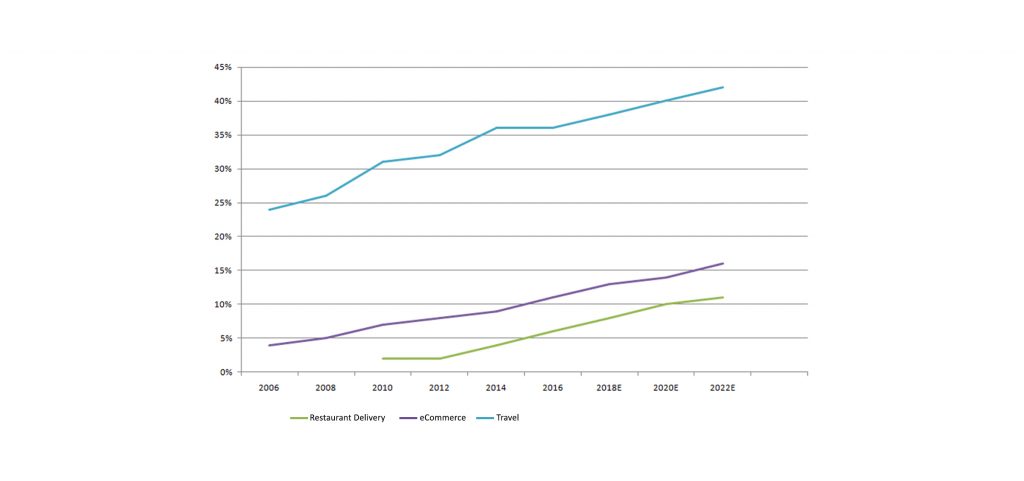Upsurge of Food Service Industry in US

Bloom of US restaurant Industry
Food Business is never bound to be limited. A whopping annual sale of $799 billion is an indicator of how restaurants open in great numbers! The increase in population growth impacts the US restaurant industry due to their busy schedules and lack of time to prepare their meals. A growing population determines not only a greater demand but also a greater supply. More and more American citizens, particularly women indulging in the workforce laid a path for the consumption of ready to eat food in a quick-service restaurant
Not only that but also the public astounds to try something unique and the tendency to opt for new menu items are the restaurant strategies to attract customers.
For the past 60 years in the United States, the economy strengthens more and the nation finds better employment opportunities, personal incomes have shown a significant rise along with the disposable income. Whether it’s a breakfast, lunch, dinner or even a cup of coffee the masses have preferred ready to consume over home food. The availability of restaurants in abundance and higher disposable incomes are also some of the reasons for the urge to spend more at a full-service restaurant in the U.S. Restaurants have been adhering to consumer tastes and diversity of zest in their restaurant marketing strategies. Franchising of restaurants beyond borders has inclined the growth in recent years.
Economic influence in Full service restaurants
In the US restaurant industry, gas prices and consumer debt are signs of economic effects. Over the past few years, a gradual decrease in gas prices implies consumers are self-sufficient to spend at a full service restaurant and are willing to commute to dine at such places specially. In recent times, the inflation of consumer debt has been observed which is due to mortgage and loan agreements. It drained the income especially for Millennials, which constrains the amount of money spent at the restaurant.
In Countries like New England and the Midwest, slower population growth and employment rate have been a setback. Hence, Restaurant owners need to identify their local market to gauge how employment might affect their business.
Fast food industry Statistics in the U.S
Did you know? According to the U.S. Department of Agriculture, Economic Research Service, the food away from home category (FAFH) amounted to 42% of household expenditure. As per data given by technomic (Technomic link), the global food service industry, which constitutes restaurants and catering services generate about annual revenue of $3 trillion.
The trending restaurant markets are North America, Asia and Western Europe. While the industry’s fastest-growing markets are Latin America and the Middle East/Africa region. 
Ecommorce and Online Delivery Growth Statistics
Different types of restaurants
There are various types of restaurants that offer a variety of experiences and luscious food. All the restaurants can be classified into two broad categories:
Full-service restaurants
Limited-service restaurants
Full-service restaurants offer full table services and can be further classified into casual dining and family dining formats.
Limited-service restaurants can be further classified into fast-food and fast-casual formats. Some reputed restaurants under this category are McDonald’s (MCD), Panera Bread (PNRA), and Chipotle Mexican Grill (CMG).
As per the statistics by technomic, limited service restaurants have the largest market share, at 55% while 44% of market share was for Full service restaurant. Bars and taverns have a market share of 1%.
Full service restaurants
Usually, Full service restaurants serve breakfast, lunch, and dinner. Customers once seated at a restaurant table, the restaurant management provides full service at this type of restaurant. Payment is done after the completion of a meal. Compared to limited-service restaurants, ordered food usually takes longer to prepare and serve them hot. Moreover, such restaurants do not offer a drive-through ordering facility. Customization of the order could be done at ease. Menu items in a full service restaurant charge more than a limited service restaurant.
These restaurants can be categorized further into casual dining restaurants and family dining restaurants
Limited service restaurants
Limited service restaurants serve lunch and dinner menus, and few of them offer breakfast, afternoon, and late-night meals too. But in these food joints, payment has to be done prior. Seating area might not be offered in some of the restaurants. Customers place their orders and obtain food to go within a few minutes. These kinds of eateries offer a drive-through ordering facility. Compared to the menu items in casual, family dining, food provided to customers in these restaurants is not much expensive.
They are further classified into fast-casual restaurants, fast food or quick service restaurant, pizza restaurants, and cafes.
Fast food restaurants
Some of the reputed food chains include Burger King (BKW), McDonald’s (MCD), Yum! Brands (YUM), Popeyes Louisiana Kitchen (PLKI), Wendy’s (WEN), Jack in the Box (JACK), and Chick-fil-A, Food here is served to customers as quickly as possible and who wouldn’t like to visit a joint with menu items being offered as low as $1?
Small food stalls business in US
Fast casual restaurants
It’s the combination of fast-food and full-service casual dining restaurants. Chipotle Mexican Grill (CMG), Noodles & Company (NDLS) and Subway are few among them. Food costs more but customers receive their orders quickly.
Café and pizza restaurants
Limited service restaurants such as Domino’s Pizza (DPZ), Papa John’s Pizza (PZZA), and café chains such as Starbucks (SBUX), Dunkin Brands (DNKN), and Krispy Kreme Doughnuts (KKD) are included in this category.
Impact of technology in the food service Industry
Adapting to new technologies is quite essential to withhold today’s competition. Restaurants are striving more and more services to consumers who value convenience the most. Mobile payments, online ordering, and home delivery have become mandatory in both the full-service and limited-service eateries. Emerging competitors such as providers of subscription meal kits could further disrupt the industry in the future.




